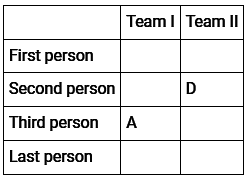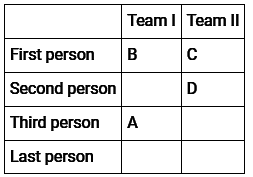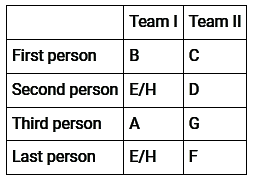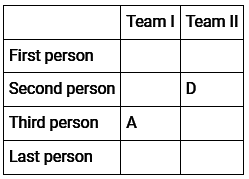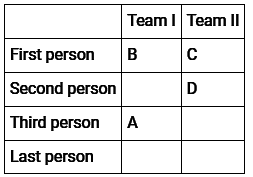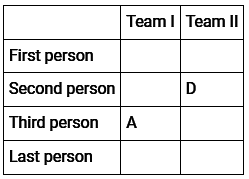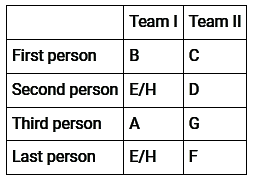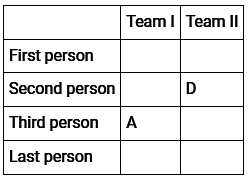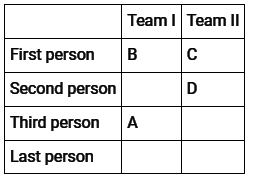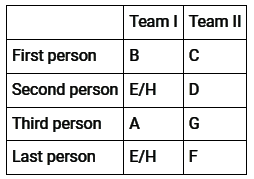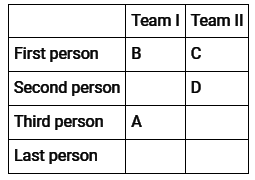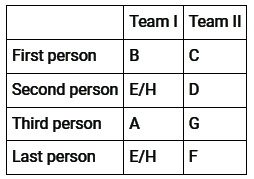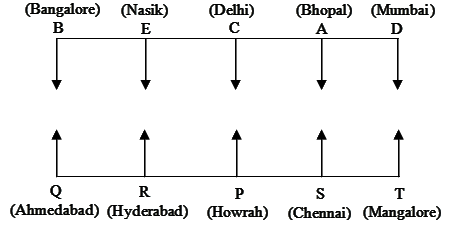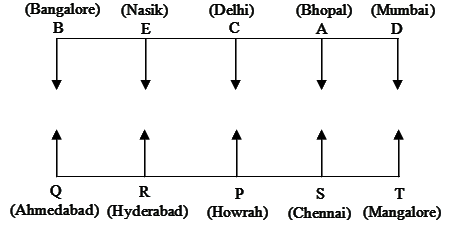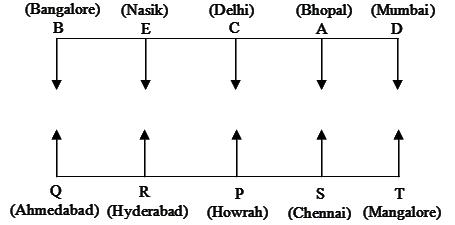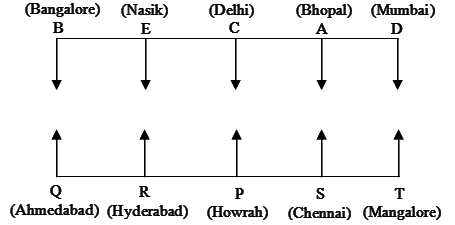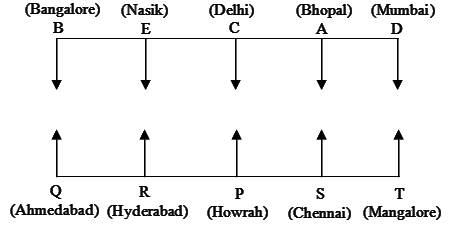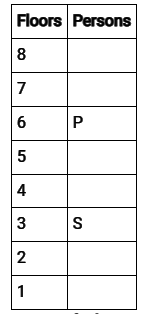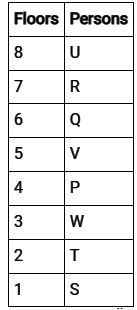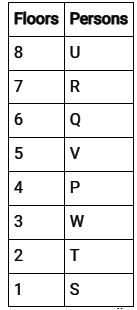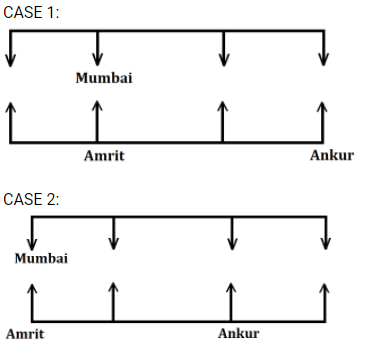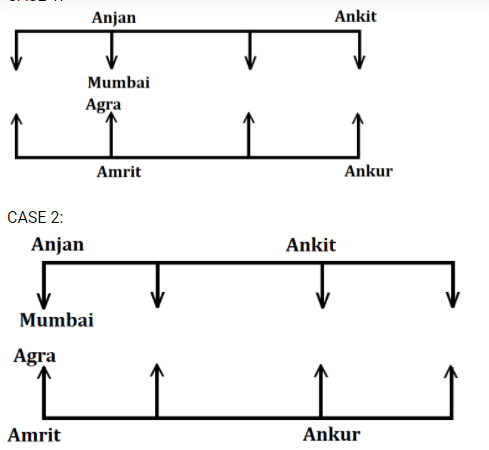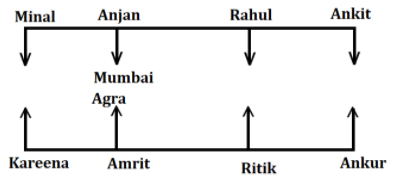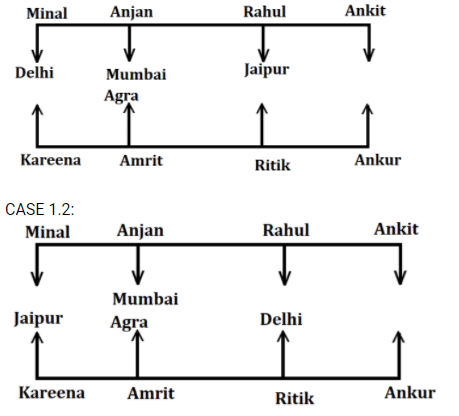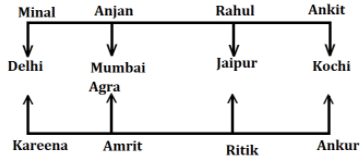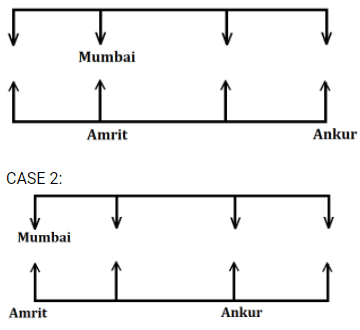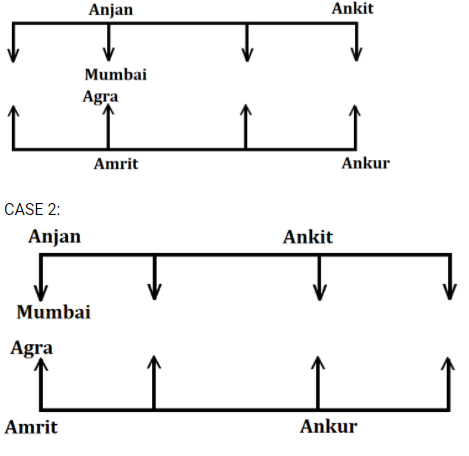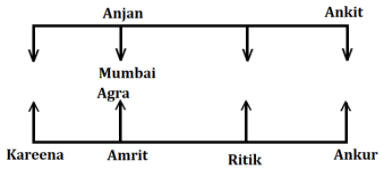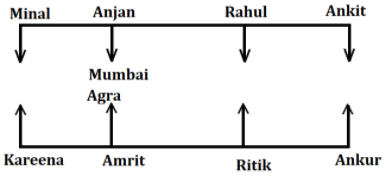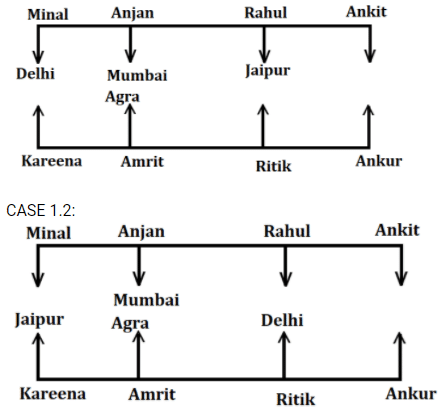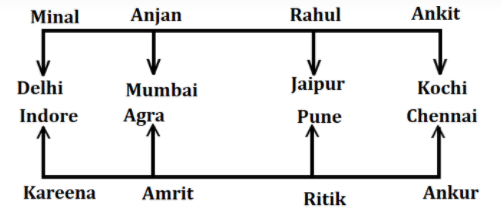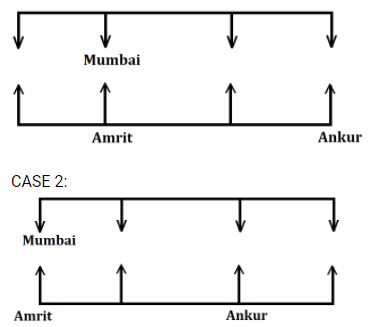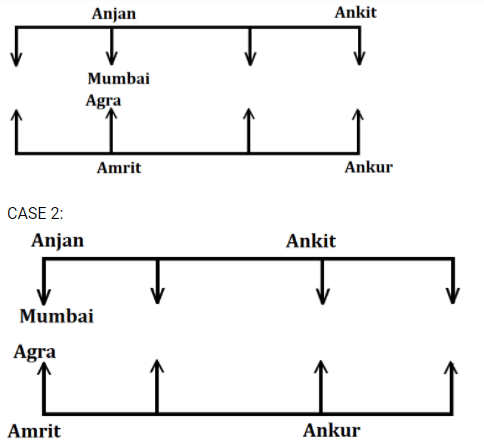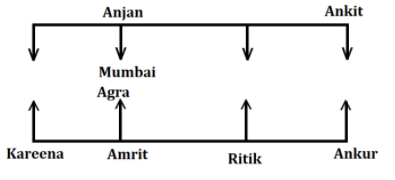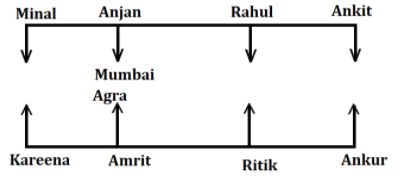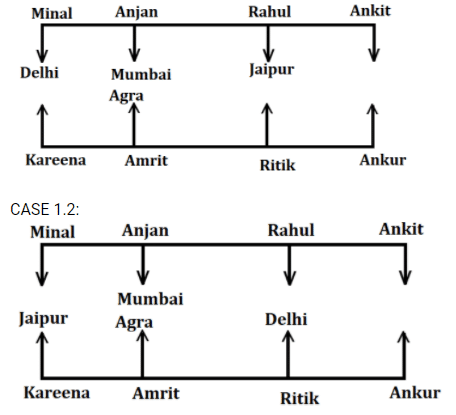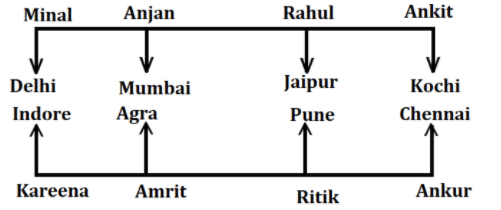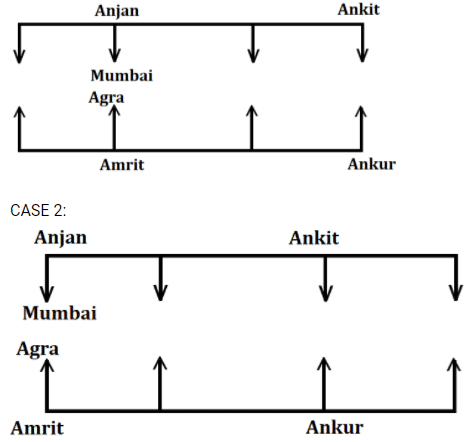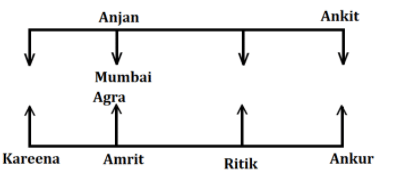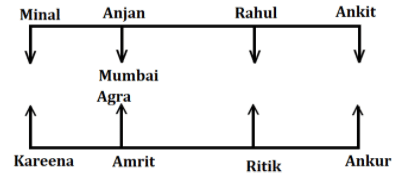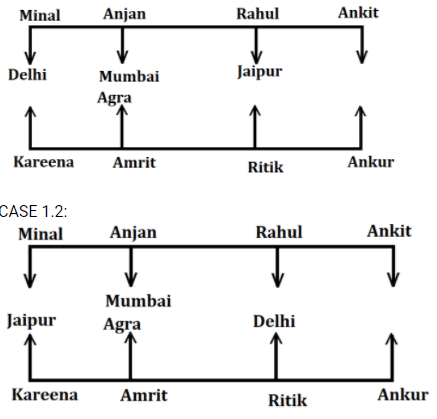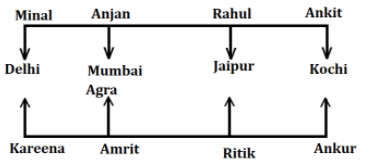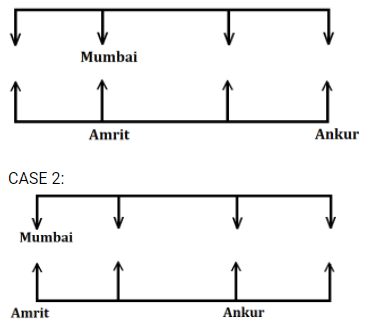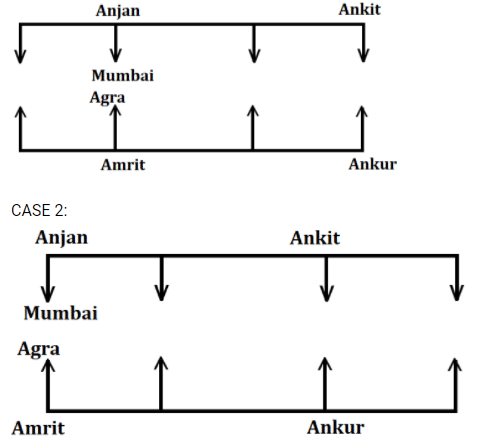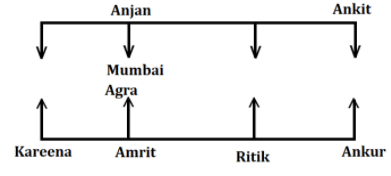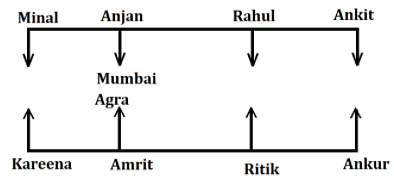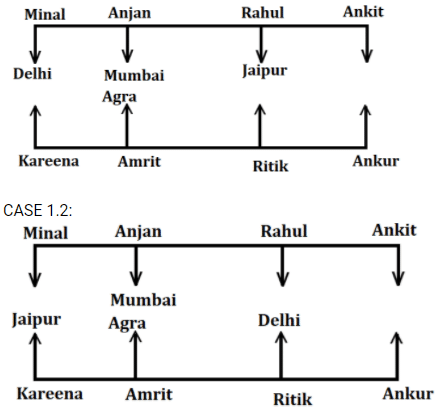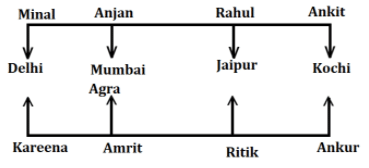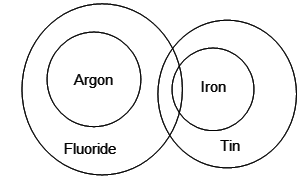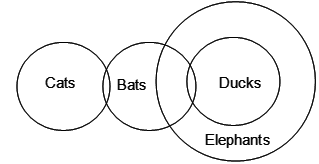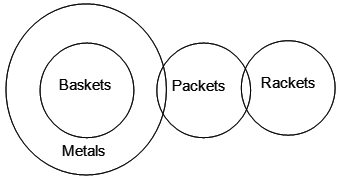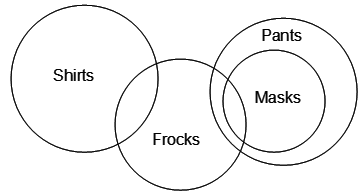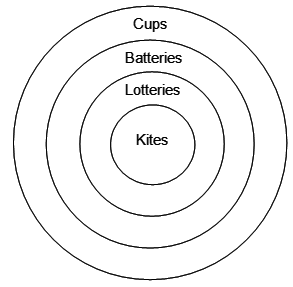IBPS SO Prelims Mock Test - 5 - Banking Exams MCQ
30 Questions MCQ Test - IBPS SO Prelims Mock Test - 5
Directions: 8 persons A, B, C, D, E, F, G and H are participated in a relay race of total 400 meters (100 meters x 4 persons). This race is between 2 teams(Team I and Team II) consisting of 4 persons each. One person from each team starts the race and run 100 meters to pass the baton to 2nd person. 2nd person then runs for 100 meters and passes baton to 3rd person and 3rd person passes to last person by running 100 meters. A runs 3rd in the team I and D runs 2nd in team II. C runs at the position prior to A but not in the same team of A. A and B runs in the same team, but baton is not exchanged between them. F exchanges baton neither with A nor with D. G is either first or 3rd person in his team.
Q. Who finishes the race for team II?
Directions: 8 persons A, B, C, D, E, F, G and H are participated in a relay race of total 400 meters (100 meters x 4 persons). This race is between 2 teams(Team I and Team II) consisting of 4 persons each. One person from each team starts the race and run 100 meters to pass the baton to 2nd person. 2nd person then runs for 100 meters and passes baton to 3rd person and 3rd person passes to last person by running 100 meters. A runs 3rd in the team I and D runs 2nd in team II. C runs at the position prior to A but not in the same team of A. A and B runs in the same team, but baton is not exchanged between them. F exchanges baton neither with A nor with D. G is either first or 3rd person in his team.
Q. If E runs in the race before H, then on which position does E run?
| 1 Crore+ students have signed up on EduRev. Have you? Download the App |
Directions: 8 persons A, B, C, D, E, F, G and H are participated in a relay race of total 400 meters (100 meters x 4 persons). This race is between 2 teams(Team I and Team II) consisting of 4 persons each. One person from each team starts the race and run 100 meters to pass the baton to 2nd person. 2nd person then runs for 100 meters and passes baton to 3rd person and 3rd person passes to last person by running 100 meters. A runs 3rd in the team I and D runs 2nd in team II. C runs at the position prior to A but not in the same team of A. A and B runs in the same team, but baton is not exchanged between them. F exchanges baton neither with A nor with D. G is either first or 3rd person in his team.
Q. Who finishes the race for team I?
Directions: 8 persons A, B, C, D, E, F, G and H are participated in a relay race of total 400 meters (100 meters x 4 persons). This race is between 2 teams(Team I and Team II) consisting of 4 persons each. One person from each team starts the race and run 100 meters to pass the baton to 2nd person. 2nd person then runs for 100 meters and passes baton to 3rd person and 3rd person passes to last person by running 100 meters. A runs 3rd in the team I and D runs 2nd in team II. C runs at the position prior to A but not in the same team of A. A and B runs in the same team, but baton is not exchanged between them. F exchanges baton neither with A nor with D. G is either first or 3rd person in his team.
Q. Who passes the baton to G?
Directions: 8 persons A, B, C, D, E, F, G and H are participated in a relay race of total 400 meters (100 meters x 4 persons). This race is between 2 teams(Team I and Team II) consisting of 4 persons each. One person from each team starts the race and run 100 meters to pass the baton to 2nd person. 2nd person then runs for 100 meters and passes baton to 3rd person and 3rd person passes to last person by running 100 meters. A runs 3rd in the team I and D runs 2nd in team II. C runs at the position prior to A but not in the same team of A. A and B runs in the same team, but baton is not exchanged between them. F exchanges baton neither with A nor with D. G is either first or 3rd person in his team.
Q. Who starts the race for team I and team II respectively?
Directions: Read the following information carefully and answer the question given below:
Ten persons are sitting in two parallel rows containing five persons each. In row 1, A, B, C, D and E are sitting and all of them are facing south. In row 2, P, Q, R, S and T are sitting and all of them are facing north. Each member seated in a row faces another member of the other row. Moreover, each of them belongs to different cities — Mumbai, Delhi, Bangalore, Hyderabad, Nasik, Chennai, Bhopal, Howrah, Ahmedabad and Mangalore, but not necessarily in the same order.
There are only two persons sitting between the person from Mumbai, who sits at an extreme end, and E. P, who sits in the middle of the row, is not an immediate neighbour of Q, who is not from Mangalore. T is sitting at an extreme end. E, from Nasik, sits to the immediate right of the person from Delhi and faces the immediate neighbour of Q. B is not sitting at the east end of the row. P is not from Ahmedabad. There is only one person between C and D. D is from Mumbai. S, from Chennai, is an immediate neighbour of the person from Mangalore and does not face the person from Bangalore. R, who is from Hyderabad, is an immediate neighbour of the person from Ahmedabad, who in turn faces the immediate neighbour of the person from Nasik. There are two persons between the persons from Bhopal and Bangalore. B is not from Bhopal. T is not from Howrah.
Q. Four of the following five are alike in a certain way based on the given sitting arrangement and hence, form a group. Which of the following is different from the group?
Directions: Read the following information carefully and answer the question given below:
Ten persons are sitting in two parallel rows containing five persons each. In row 1, A, B, C, D and E are sitting and all of them are facing south. In row 2, P, Q, R, S and T are sitting and all of them are facing north. Each member seated in a row faces another member of the other row. Moreover, each of them belongs to different cities — Mumbai, Delhi, Bangalore, Hyderabad, Nasik, Chennai, Bhopal, Howrah, Ahmedabad and Mangalore, but not necessarily in the same order.
There are only two persons sitting between the person from Mumbai, who sits at an extreme end, and E. P, who sits in the middle of the row, is not an immediate neighbour of Q, who is not from Mangalore. T is sitting at an extreme end. E, from Nasik, sits to the immediate right of the person from Delhi and faces the immediate neighbour of Q. B is not sitting at the east end of the row. P is not from Ahmedabad. There is only one person between C and D. D is from Mumbai. S, from Chennai, is an immediate neighbour of the person from Mangalore and does not face the person from Bangalore. R, who is from Hyderabad, is an immediate neighbour of the person from Ahmedabad, who in turn faces the immediate neighbour of the person from Nasik. There are two persons between the persons from Bhopal and Bangalore. B is not from Bhopal. T is not from Howrah.
Q. Who is from Howrah?
Directions: Read the following information carefully and answer the question given below:
Ten persons are sitting in two parallel rows containing five persons each. In row 1, A, B, C, D and E are sitting and all of them are facing south. In row 2, P, Q, R, S and T are sitting and all of them are facing north. Each member seated in a row faces another member of the other row. Moreover, each of them belongs to different cities — Mumbai, Delhi, Bangalore, Hyderabad, Nasik, Chennai, Bhopal, Howrah, Ahmedabad and Mangalore, but not necessarily in the same order.
There are only two persons sitting between the person from Mumbai, who sits at an extreme end, and E. P, who sits in the middle of the row, is not an immediate neighbour of Q, who is not from Mangalore. T is sitting at an extreme end. E, from Nasik, sits to the immediate right of the person from Delhi and faces the immediate neighbour of Q. B is not sitting at the east end of the row. P is not from Ahmedabad. There is only one person between C and D. D is from Mumbai. S, from Chennai, is an immediate neighbour of the person from Mangalore and does not face the person from Bangalore. R, who is from Hyderabad, is an immediate neighbour of the person from Ahmedabad, who in turn faces the immediate neighbour of the person from Nasik. There are two persons between the persons from Bhopal and Bangalore. B is not from Bhopal. T is not from Howrah.
Q. Which of the following statements is definitely false?
Directions: Read the following information carefully and answer the question given below:
Ten persons are sitting in two parallel rows containing five persons each. In row 1, A, B, C, D and E are sitting and all of them are facing south. In row 2, P, Q, R, S and T are sitting and all of them are facing north. Each member seated in a row faces another member of the other row. Moreover, each of them belongs to different cities — Mumbai, Delhi, Bangalore, Hyderabad, Nasik, Chennai, Bhopal, Howrah, Ahmedabad and Mangalore, but not necessarily in the same order.
There are only two persons sitting between the person from Mumbai, who sits at an extreme end, and E. P, who sits in the middle of the row, is not an immediate neighbour of Q, who is not from Mangalore. T is sitting at an extreme end. E, from Nasik, sits to the immediate right of the person from Delhi and faces the immediate neighbour of Q. B is not sitting at the east end of the row. P is not from Ahmedabad. There is only one person between C and D. D is from Mumbai. S, from Chennai, is an immediate neighbour of the person from Mangalore and does not face the person from Bangalore. R, who is from Hyderabad, is an immediate neighbour of the person from Ahmedabad, who in turn faces the immediate neighbour of the person from Nasik. There are two persons between the persons from Bhopal and Bangalore. B is not from Bhopal. T is not from Howrah.
Q. 'A' belongs to which of the following cities?
Directions: Read the following information carefully and answer the question given below:
Ten persons are sitting in two parallel rows containing five persons each. In row 1, A, B, C, D and E are sitting and all of them are facing south. In row 2, P, Q, R, S and T are sitting and all of them are facing north. Each member seated in a row faces another member of the other row. Moreover, each of them belongs to different cities — Mumbai, Delhi, Bangalore, Hyderabad, Nasik, Chennai, Bhopal, Howrah, Ahmedabad and Mangalore, but not necessarily in the same order.
There are only two persons sitting between the person from Mumbai, who sits at an extreme end, and E. P, who sits in the middle of the row, is not an immediate neighbour of Q, who is not from Mangalore. T is sitting at an extreme end. E, from Nasik, sits to the immediate right of the person from Delhi and faces the immediate neighbour of Q. B is not sitting at the east end of the row. P is not from Ahmedabad. There is only one person between C and D. D is from Mumbai. S, from Chennai, is an immediate neighbour of the person from Mangalore and does not face the person from Bangalore. R, who is from Hyderabad, is an immediate neighbour of the person from Ahmedabad, who in turn faces the immediate neighbour of the person from Nasik. There are two persons between the persons from Bhopal and Bangalore. B is not from Bhopal. T is not from Howrah.
Q. If 'Mumbai' is related to 'Bhopal' in a certain way based on the given sitting arrangement, then 'Mangalore' is related to which of the following?
Directions : Study the following information carefully and answer the questions given below:
Eight persons P, Q, R, S, T, U, V and W not necessarily in the same order live on eight floors of a building. The lowermost floor is numbered 1 and the floor above it is numbered as 2 and so on. Two persons live between P and S, who lives on an odd numbered floor. P lives above S. P doesn't live on the top floor. R lives just above Q. Two persons live between P and R. The number of persons living above R is same as that living below T. The number of persons living between T and P is same as the persons living between R and V. U lives two floors above Q.
Q. Which of the following does not belong to the group?
Directions : Study the following information carefully and answer the questions given below:
Eight persons P, Q, R, S, T, U, V and W not necessarily in the same order live on eight floors of a building. The lowermost floor is numbered 1 and the floor above it is numbered as 2 and so on. Two persons live between P and S, who lives on an odd numbered floor. P lives above S. P doesn't live on the top floor. R lives just above Q. Two persons live between P and R. The number of persons living above R is same as that living below T. The number of persons living between T and P is same as the persons living between R and V. U lives two floors above Q.
Q. Who among the following lives on the 6th floor?
Which of the following order of letters (from left to right) in the blanks makes the expression, B = D possibly true?
____ < ____ ? ____ ?____>_____>______
In each question below is given a statement followed by two assumptions numbered I and II. An assumption is something supposed or taken for granted. You have to consider the statement and the following assumptions and decide which of the assumptions is implicit in the statement.
Statement
During the 18 years when El Nino was active over this region, Chennai has been experiencing hotter weather between January and May, compared to non-El Nino years
Assumptions
I. El Nino is responsible for increase in average temperature in Chennai
II. Chennai is the hottest metropolitan city in the country
In each question below is given a statement followed by two assumptions numbered I and II. An assumption is something supposed or taken for granted. You have to consider the statement and the following assumptions and decide which of the assumptions is implicit in the statement.
Statement: Live a full life. Don’t drink and drive. — Delhi Traffic Police in its advertisement.
Assumptions:
I. Driving after drinking may cause accidents.
II. Some people drive after drinking.
Directions: A number and word arrangement machine when given an input of line of numbers and words, rearranges them following a particular rule in each step. Given below is an illustration of input and rearrangement:
Input: love 19 ajay 12 once 94 use 32 time 47 wickedly
Step I: ajay love 19 12 once 94 use 32 47 time wickedly
Step II: ajay once 19 12 94 use 32 47 love time wickedly
Step III: ajay once use 19 12 94 32 47 love time wickedly
Step IV: ajay once use 94 19 12 32 47 love time wickedly
Step V: ajay once use 94 47 19 12 32 love time wickedly
Step VI: ajay once use 94 47 32 19 12 love time wickedly
Now, as per the rules followed in the above steps, find out the appropriate steps for the input given below and answer the question.
Input: cast 17 omit 13 ace fan 23 rate 34 uncut 56
Q. Which step is "ace omit uncut 56 17 13 23 34 cast fan rate" for the given input?
Directions: A number and word arrangement machine when given an input of line of numbers and words, rearranges them following a particular rule in each step. Given below is an illustration of input and rearrangement:
Input: love 19 ajay 12 once 94 use 32 time 47 wickedly
Step I: ajay love 19 12 once 94 use 32 47 time wickedly
Step II: ajay once 19 12 94 use 32 47 love time wickedly
Step III: ajay once use 19 12 94 32 47 love time wickedly
Step IV: ajay once use 94 19 12 32 47 love time wickedly
Step V: ajay once use 94 47 19 12 32 love time wickedly
Step VI: ajay once use 94 47 32 19 12 love time wickedly
Now, as per the rules followed in the above steps, find out the appropriate steps for the input given below and answer the question.
Input: cast 17 omit 13 ace fan 23 rate 34 uncut 56
Q. Which of the following is 4th to the right of the 4th word/number from the left end in Step III of the given input?
Directions: A number and word arrangement machine when given an input of line of numbers and words, rearranges them following a particular rule in each step. Given below is an illustration of input and rearrangement:
Input: love 19 ajay 12 once 94 use 32 time 47 wickedly
Step I: ajay love 19 12 once 94 use 32 47 time wickedly
Step II: ajay once 19 12 94 use 32 47 love time wickedly
Step III: ajay once use 19 12 94 32 47 love time wickedly
Step IV: ajay once use 94 19 12 32 47 love time wickedly
Step V: ajay once use 94 47 19 12 32 love time wickedly
Step VI: ajay once use 94 47 32 19 12 love time wickedly
Now, as per the rules followed in the above steps, find out the appropriate steps for the input given below and answer the question.
Input: cast 17 omit 13 ace fan 23 rate 34 uncut 56
Q. Which of the following is the third element from left in the third step for the given input?
Directions: A number and word arrangement machine when given an input of line of numbers and words, rearranges them following a particular rule in each step. Given below is an illustration of input and rearrangement:
Input: love 19 ajay 12 once 94 use 32 time 47 wickedly
Step I: ajay love 19 12 once 94 use 32 47 time wickedly
Step II: ajay once 19 12 94 use 32 47 love time wickedly
Step III: ajay once use 19 12 94 32 47 love time wickedly
Step IV: ajay once use 94 19 12 32 47 love time wickedly
Step V: ajay once use 94 47 19 12 32 love time wickedly
Step VI: ajay once use 94 47 32 19 12 love time wickedly
Now, as per the rules followed in the above steps, find out the appropriate steps for the input given below and answer the question.
Input: cast 17 omit 13 ace fan 23 rate 34 uncut 56
Q. How many steps are required to arrange the given input based on the above pattern?
Directions: A number and word arrangement machine when given an input of line of numbers and words, rearranges them following a particular rule in each step. Given below is an illustration of input and rearrangement:
Input: love 19 ajay 12 once 94 use 32 time 47 wickedly
Step I: ajay love 19 12 once 94 use 32 47 time wickedly
Step II: ajay once 19 12 94 use 32 47 love time wickedly
Step III: ajay once use 19 12 94 32 47 love time wickedly
Step IV: ajay once use 94 19 12 32 47 love time wickedly
Step V: ajay once use 94 47 19 12 32 love time wickedly
Step VI: ajay once use 94 47 32 19 12 love time wickedly
Now, as per the rules followed in the above steps, find out the appropriate steps for the input given below and answer the question.
Input: cast 17 omit 13 ace fan 23 rate 34 uncut 56
Q. What is the last step for the given input?
Direction: Study the following information carefully and answer the question given below.
Eight people are sitting in two parallel rows containing four people each such that they are equidistant from each other. In row 1, Kareena, Amrit, Ritik, and Ankur are sitting facing North. In row 2, Minal, Anjan, Rahul, and Ankit are sitting facing south. All the members are from different cities viz. Delhi, Agra, Indore, Mumbai, Jaipur, Kochi, Pune, and Chennai, but not necessarily in the same order.
Amrit sits second to the left of Ankur and faces the person who is from Mumbai. Minal sits at one of the extreme ends of the row but does not face the person who is from Chennai. Anjan is sitting second to the right of Ankit and faces Amrit who is from Agra. Persons coming from Jaipur and Kochi sit adjacent to each other. The person who is from Pune sits adjacent to the person who is from Chennai but not at the end of the row. The person who is from Jaipur sits second to the left of the person who is from Delhi. More than one person sits between Ankur and Kareena.
Q. Who among the following comes from Kochi?
Direction: Study the following information carefully and answer the question given below.
Eight people are sitting in two parallel rows containing four people each such that they are equidistant from each other. In row 1, Kareena, Amrit, Ritik, and Ankur are sitting facing North. In row 2, Minal, Anjan, Rahul, and Ankit are sitting facing south. All the members are from different cities viz. Delhi, Agra, Indore, Mumbai, Jaipur, Kochi, Pune, and Chennai, but not necessarily in the same order.
Amrit sits second to the left of Ankur and faces the person who is from Mumbai. Minal sits at one of the extreme ends of the row but does not face the person who is from Chennai. Anjan is sitting second to the right of Ankit and faces Amrit who is from Agra. Persons coming from Jaipur and Kochi sit adjacent to each other. The person who is from Pune sits adjacent to the person who is from Chennai but not at the end of the row. The person who is from Jaipur sits second to the left of the person who is from Delhi. More than one person sits between Ankur and Kareena.
Q. Who among the following comes from Delhi?
Direction: Study the following information carefully and answer the question given below.
Eight people are sitting in two parallel rows containing four people each such that they are equidistant from each other. In row 1, Kareena, Amrit, Ritik, and Ankur are sitting facing North. In row 2, Minal, Anjan, Rahul, and Ankit are sitting facing south. All the members are from different cities viz. Delhi, Agra, Indore, Mumbai, Jaipur, Kochi, Pune, and Chennai, but not necessarily in the same order.
Amrit sits second to the left of Ankur and faces the person who is from Mumbai. Minal sits at one of the extreme ends of the row but does not face the person who is from Chennai. Anjan is sitting second to the right of Ankit and faces Amrit who is from Agra. Persons coming from Jaipur and Kochi sit adjacent to each other. The person who is from Pune sits adjacent to the person who is from Chennai but not at the end of the row. The person who is from Jaipur sits second to the left of the person who is from Delhi. More than one person sits between Ankur and Kareena.
Q. Four of the following five options are alike in a certain way and hence form a group. Which of them doesn’t belong to the group?
Direction: Study the following information carefully and answer the question given below.
Eight people are sitting in two parallel rows containing four people each such that they are equidistant from each other. In row 1, Kareena, Amrit, Ritik, and Ankur are sitting facing North. In row 2, Minal, Anjan, Rahul, and Ankit are sitting facing south. All the members are from different cities viz. Delhi, Agra, Indore, Mumbai, Jaipur, Kochi, Pune, and Chennai, but not necessarily in the same order.
Amrit sits second to the left of Ankur and faces the person who is from Mumbai. Minal sits at one of the extreme ends of the row but does not face the person who is from Chennai. Anjan is sitting second to the right of Ankit and faces Amrit who is from Agra. Persons coming from Jaipur and Kochi sit adjacent to each other. The person who is from Pune sits adjacent to the person who is from Chennai but not at the end of the row. The person who is from Jaipur sits second to the left of the person who is from Delhi. More than one person sits between Ankur and Kareena.
Q. Which pair among the following sits at the extreme end of the row?
Direction: Study the following information carefully and answer the question given below.
Eight people are sitting in two parallel rows containing four people each such that they are equidistant from each other. In row 1, Kareena, Amrit, Ritik, and Ankur are sitting facing North. In row 2, Minal, Anjan, Rahul, and Ankit are sitting facing south. All the members are from different cities viz. Delhi, Agra, Indore, Mumbai, Jaipur, Kochi, Pune, and Chennai, but not necessarily in the same order.
Amrit sits second to the left of Ankur and faces the person who is from Mumbai. Minal sits at one of the extreme ends of the row but does not face the person who is from Chennai. Anjan is sitting second to the right of Ankit and faces Amrit who is from Agra. Persons coming from Jaipur and Kochi sit adjacent to each other. The person who is from Pune sits adjacent to the person who is from Chennai but not at the end of the row. The person who is from Jaipur sits second to the left of the person who is from Delhi. More than one person sits between Ankur and Kareena.
Q. Who among the following faces Anjan?
Directions: The item below consists of three statements followed by three conclusions. You have to take the given statements to be true even if they seem to be at variance from commonly known facts. Read all the conclusions and then decide which of them logically follow(s) from the given statements disregarding commonly known facts.
Statements:
All argon is fluoride.
Some fluoride is iron.
All iron is tin.
Conclusions:
I. All fluoride is argon.
II. All iron is argon.
III. Some tin is fluoride.
Directions: The item below consists of three statements followed by three conclusions. You have to take the given statements to be true even if they seem to be at variance from commonly known facts. Read all the conclusions and then decide which of them logically follow(s) from the given statements disregarding commonly known facts.
Statements:
Some cats are bats.
Some bats are ducks.
All ducks are elephants.
Conclusions:
I. Some ducks are cats.
II. Some elephants are bats.
III. Some elephants are cats.
Directions: The item below consists of three statements followed by three conclusions. You have to take the given statements to be true even if they seem to be at variance from commonly known facts. Read all the conclusions and then decide which of them logically follow(s) from the given statements disregarding commonly known facts.
Statements:
All baskets are metals.
Some metals are packets.
Some packets are rackets.
Conclusions:
I. All baskets are rackets.
II. Some rackets are metals.
III. All baskets are packets.
Directions: The item below consists of three statements followed by three conclusions. You have to take the given statements to be true even if they seem to be at variance from commonly known facts. Read all the conclusions and then decide which of them logically follow(s) from the given statements disregarding commonly known facts.
Statements:
Some shirts are frocks.
Some frocks are masks.
All masks are pants.
Conclusions:
I. Some pants are frocks.
II. All frocks are shirts.
III. Some masks are frocks.
Directions: The item below consists of three statements followed by three conclusions. You have to take the given statements to be true even if they seem to be at variance from commonly known facts. Read all the conclusions and then decide which of them logically follow(s) from the given statements disregarding commonly known facts.
Statements:
All kites are lotteries.
All lotteries are batteries.
All batteries are cups.
Conclusions:
I. Some cups are lotteries.
II. Some batteries are kites.
III. Some cups are kites.


